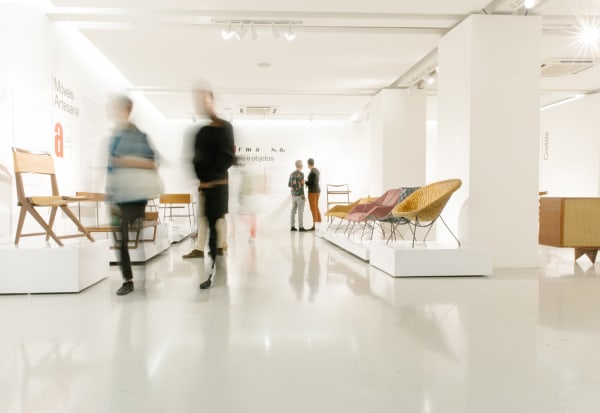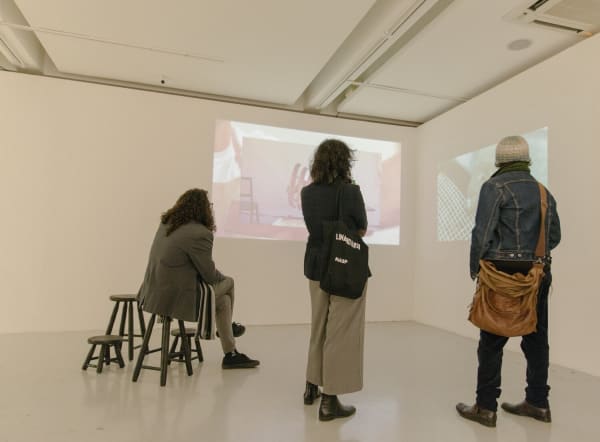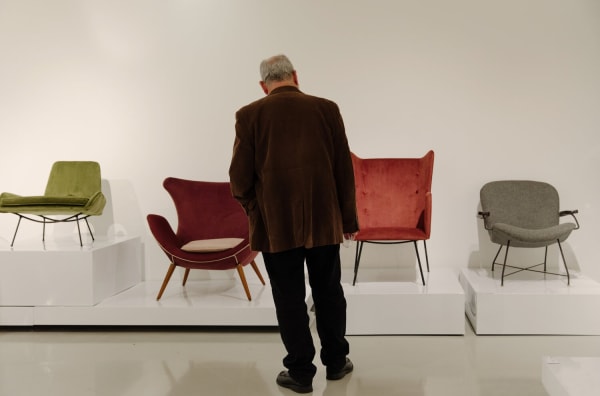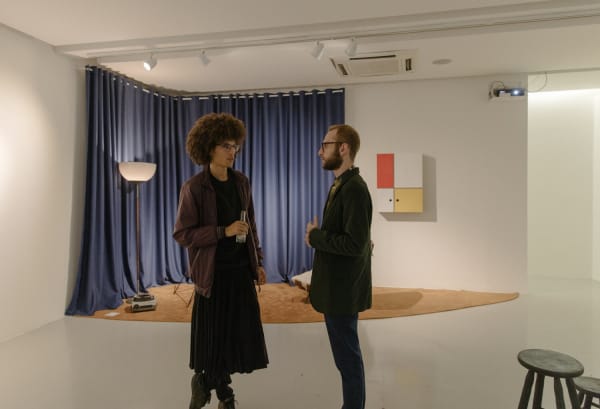-
-

-
INTRO
Brazil underwent profound social and economic changes in the middle of the twentieth century, resulting in the growth and verticalization of its urban centers. Contingents of immigrants, many of whom came to the country after World War II to start a new life, went to these cities, and there was a general sense of optimism. In the architecture and design fields, the development of a modern vocabulary and an industry capable of producing new materials provided the tools to respond to the challenges of furnishing a new type of dwelling and catering to a cosmopolitan lifestyle.
In 1948, Italian immigrant Carlo Hauner (1927-1996) arrived in São Paulo and immersed himself in this culture. He founded the company Móveis Artesanal in 1950 to produce modern furniture and was its principal designer until the arrival of Martin Eisler (1913-1977), an Austrian immigrant who came to Brazil through Argentina, in 1953. The two would be responsible for creating pieces that became classics of modern Brazilian design, running a store that was known as a reference of sophistication at the time. Artesanal was also an incubator for design in Brazil, having Ernesto and Georgia Hauner and Sergio Rodrigues amongst its employees.
Although successful, however, the company was short-lived: it was restructured as Forma in 1955 while Carlo Hauner left the business. This is the largest exhibition ever held in Brazil documenting the work of these two prominent designers during their time at Móveis Artesanal and Forma. Essential pieces are gathered in the same space for the first time since the 1950s, portraying what this moment was like and paths that derived from the encounters facilitated by the company. -

-
HONING TALENTS
Carlo Hauner started Móveis Artesanal with Pau Bra’s equipment and an investment by Italian Count Paolo Grasselli. The factory was located at Itaim Bibi, and Hauner was head of the design department, creating most of the furniture the company made and sold.
Móveis Artesanal’s first ads appeared in Habitat magazine, which was edited by the Bardi couple. In them, the company announces to make modern furniture and claims responsibility for the execution of Masp’s furniture, designed by Lina for Pietro’s venture.
In 1953, Martin Eisler, then living in Argentina, visited São Paulo to develop the interior design for his brother-in-law’s apartment, Ernesto Wolf. He had his furniture manufactured at Artesanal and Hauner liked what he saw so he suggested a partnership, which began shortly after featuring an investment by Wolf and Grasselli’s departure. -
MÓVEIS ARTESANAL PARANAENSE
Sergio Rodrigues (1927—2014) graduated as an architect from the National School of Fine Arts in Rio de Janeiro in 1951 and was immediately invited to join the team responsible for the Curitiba Civic Center project. While there he was visited by Carlo Hauner, who sought to sell Artesanal furniture to the venture, and the two established a friendship.
Rodrigues considered setting up a modern furniture store in Curitiba, the first of its kind in the city. He proposed to Hauner opening a space that sold the furniture of the São Paulo company, named the new business Móveis Artesanal Paranaense, and opened its doors in 1953.
Unfortunately, the venture was a failure: although many patrons visited the shop, it sold next to nothing. Rodrigues then wrote a letter to Hauner, who in return invited him to work in São Paulo - an invitation promptly accepted - making the architect from Rio one of the designers at Artesanal.
GALERIA ARTESANAL
At the end of 1953, Galeria Artesanal opened its doors in Barão de Itapetininga Street. As a three-story store in one of the most famous shopping streets of São Paulo, it combined furniture sales with an art gallery. Rodrigues started working in the city within this space, hiring Georgia Morpurgo (maiden name) (1931-) as his assistant.
She would soon be put in charge of setting up storefronts and interiors, devising strategies such as leaving a pair of glasses on top of an open book, as if someone was just in the armchair nearby, or opening prints for sale on a large table, which immediately caught the public’s eye.
Her goal was to create more comfortable environments because she realized that people found it hard to accept and want modern settings. Placing ordinary objects broke the austerity of industrial products and brought an element of surprise. In 1955, Georgia and Carlo’s brother, Ernesto Hauner, would marry, with Rodrigues as their best man. -
FROM ARTESANAL TO FORMA
Ernesto Hauner (1931-2002) had worked as a draftsman at Studio Palma and later joined the team at Móveis Artesanal. He also opened a shop with his older brother, Carlo Hauner, to sell glass and ceramic decoration on Augusta Street. They designed some of the objects and produced them at H. Cerâmica, naming their store Forma.
Since the members of Artesanal wanted to change the name of the company to make it more attractive to the corporate market and the Hauners were involved in both businesses, the companies went through an organic merger between 1954 and 55, in which the name Forma started designating the production of Móveis Artesanal. In parallel, an internal restructuring process took place in the company, in which Rodrigues left the firm in late 1954, Carlo Hauner in 1955, and Ernesto and Georgia in 1957.
CARLO HAUNER
Carlo Hauner was born in Brescia, Italy, in 1927. He graduated in technical and artistic drawing at the Accademia di Belle Arti di Brera in Milan, and in 1948 exhibited works at the Venice Biennale. That same year, he immigrated to Brazil and quickly acquainted himself with the artistic circles of São Paulo, forging connections with other Italian immigrants. Between 1950 and 1955 Hauner directed Móveis Artesanal, then decided to return to Italy and founded Forma di Brescia in his homeland as a branch of the Brazilian Forma. The Italian company was responsible for manufacturing pieces that Sergio Rodrigues was to design for the Brazilian Embassy in Rome, and throughout his career Hauner designed for several European companies. In the 1970s, Hauner changed careers once again: he moved to Salina, in Sicily, devoting himself to winemaking and painting. Carlo Hauner passed away in 1996. -
MARTIN EISLER
Martin Eisler was born in Vienna in 1913, graduated as an architect in 1936 having contact with modernist teachers, and then moved to Prague. In 1938, Eisler decided to immigrate to Argentina due to the rise of fascist regimes in Europe, acquired citizenship and began working as an architect and interior and set designer. He met his wife in 1940 when he renovated the home of her father, Alfredo Wolf. In 1953, Eisler came to São Paulo to develop the interior design for his brother-in-law’s apartment, Ernesto Wolf, and the furniture he created was manufactured at Móveis Artesanal. Following that, Eisler eventually moved to São Paulo, became a partner in the company and one of its principal designers. After the business was restructured as Forma, Eisler took over as artistic director and continued to work there for decades to come, albeit away from the drawing board. Martin Eisler passed away in 1977.
FORMA GROWS
After Móveis Artesanal was restructured as Forma and the designers involved with the company in those early years left, the enterprise underwent a deep restructuring process. Following the expansion of stores and modifications in the designs offered, Artesanal partnered with Knoll International in 1959 to produce licensed products from the American company.
Knoll was founded in New York in 1938 by German immigrant Hans Knoll as a modern furniture factory and store. From 1946 onwards, he and his wife Florence sought out prominent designers to create their products. Names such as Eero Saarinen, Harry Bertoia, and Mies van der Rohe consequently had their furniture designs made by Knoll, and because of Forma, their pieces became available in Brazil as well. -
INTERIEUR FORMA
While living in Argentina, Martin Eisler helped in founding furniture company Interieur, which remained active after he moved to Brazil. At the turn of the 1960s, shortly after Forma began to manufacture Knoll pieces, the Argentine company likewise began selling them, underwent a reorganization, and was renamed Interieur Forma.
Fellow Austrians Susi Aczel and Arnold Hakel were responsible for running the company and created pieces that were produced there. Like Móveis Artesanal and Forma in Brazil, Interieur Forma played a decisive role in the modernization of domestic environments in Argentina and helped taking Latin American design to the world. -
THE MODERNIZATION OF FURNITURE IN BRAZIL
The furniture designed by Ernesto Hauner and Martin Eisler, manufactured by Artesanal and Forma, was affiliated to international modernism and made under a high-quality rationalized production system. These two designers, evidently immigrants, did not seek to create authentically Brazilian furniture, as Sergio Rodrigues’s pieces would become known. Nor did they plunge into critical-regionalist experiments, as Lina Bo Bardi would in subsequent years.
Hauner and Eisler did not perceive wood as their primary material or traditional woodwork as reference for design solutions, unlike Joaquim Tenreiro or Branco e Preto, despite the latter’s eye on foreign creations. Notwithstanding, Eisler and Hauner’s design was not unique nor their market share exclusive: their pieces had common traits with many endeavors that, each in their own way, sought to answer the question of how new elite urban interiors should be furnished. -
FULL CREDITS
Curator: Isabela MilagreCuratorial consulting and text: Mina Warchavchik Hugerth
Research: Isabela Milagre, Mina Warchavchik Hugerth
Exhibition design: Giovana Melo, Igor Vicente, Isabela Milagre, Felipe Victor, Vitória Mazzoni
Production: Vitória Mazzoni
Graphic Design: Felipe Victor
Photo and Video: Beatriz Xavier, Larissa Dare
Restoration: Amauri Mendes, Ataídes Ferreira, Paulo Bianchi, Pedro Ramos
Staff: Giulia Lorenzi, Fernando França, Nivea Abrantes, Marcelo Roveri, Raimundo do Nascimento, Vitor Roma
















